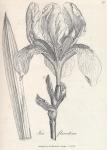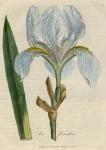039. Iris florentina. Florentine orris, or iris.

 Also see 040. Iris pseudacorus. Yellow water flag.
Also see 040. Iris pseudacorus. Yellow water flag.
Synonyma. Iris florentina. Pharm. Lond. & Edinb. Gerard. Emac. p. 52.
Iris alba florentina. Bauh. Pin. p. 31. Parkinson Perad. p. 180.
Iris flore albo. J. Bauh. Hist. ii. 719. Raii Hist. p. 1180. Spec. 2.
Iris barbata foliis ensiformibus glabris brevioribus, scapo subbifloro. Thunb. Dict. de Iride. n. 5.
(greek) Dioscor. et Graec.
Class Triandria. Ord. Monogynia. L. Gen. Plant. 59.
Ess. Gen. Ch. Cor. 6-petala, inaequalis, petalis alternis geniculato-patentibus. Stigmata petaliformia, cucullato-bilabiata. Thunb. Diss. de Iride.
Cor. 6-partita: Petalis alternis reflexis. Stigmata petaliformia. Lin.
Spec. Char. I. corollis barbatis, caule foliis altiore subbifloro, floribus sesslibus.
The root is perennial, tuberous, ponderous, somewhat compressed, branched, fibrous, externally brown, internally of a yellowish white colour: the leaves are sword-shaped, radical, inserted in each other, pointed, shorter than the stem, and of a dull green colour: the stem is round, smooth, jointed, and about a foot in height: the flowers are large, upright, of a white colour, and often have a bluish tinge: the calyx is a spatha of two valves: the corolla divides into six segments or petals, of these, three stand erect, the other three, which are of an irregular oval shape, turn back, and at the base are painted with brown lines, and bearded with yellow hairs; the filaments are three, and crowned with long yellow antherae; the style is short and simple; the stigma separates into three expanded segments, resembling petals, which arch over the stamina; the germen is long, of an obtusely triangular shape, and placed below the corolla; the capsule has three cavities, which contain numerous flat brown seeds.
This Iris is a native of Italy, and flowers in June: it was cultivated in England by Gerard in 1596, and is now constantly propagated by the florists; but the roots of the Orris produced in this country have neither the odour, nor the other qualities, of those of warmer climates, so that for medicinal use they are commonly imported from Leghorn.
This root, in its recent state, is extremely acrid, and when chewed excites a pungent heat in the mouth, which continues several hours: on being dried, this acrimony is almost wholly dissipated, the taste slightly bitter, and the smell agreeable, and approaching to that of violets. No essential oil has been hitherto obtained from this root, but spirituous tinctures of it contain more of its virtues than watery infusions. The fresh root is a powerful cathartic, and for this purpose its juice has been employed in the dose of a dram and upwards in dropsies. It is now chiefly used in its dried state, and ranked as a pectoral, or expectorant, and hence has a place in the Trochisci amyli of the London Pharm. We have however no evidence of its expectorant powers, and therefore must consider it as valuable only for the pleasantness of the perfume, and the flavour which it communicates. ["What this might do in its recent and acrid state, I cannot determine; but in the dried state, in which we commonly have it in our shops, we are persuaded of its being a very insignincant expectorant." Cullen M. M. v. 2. p. 459.]

